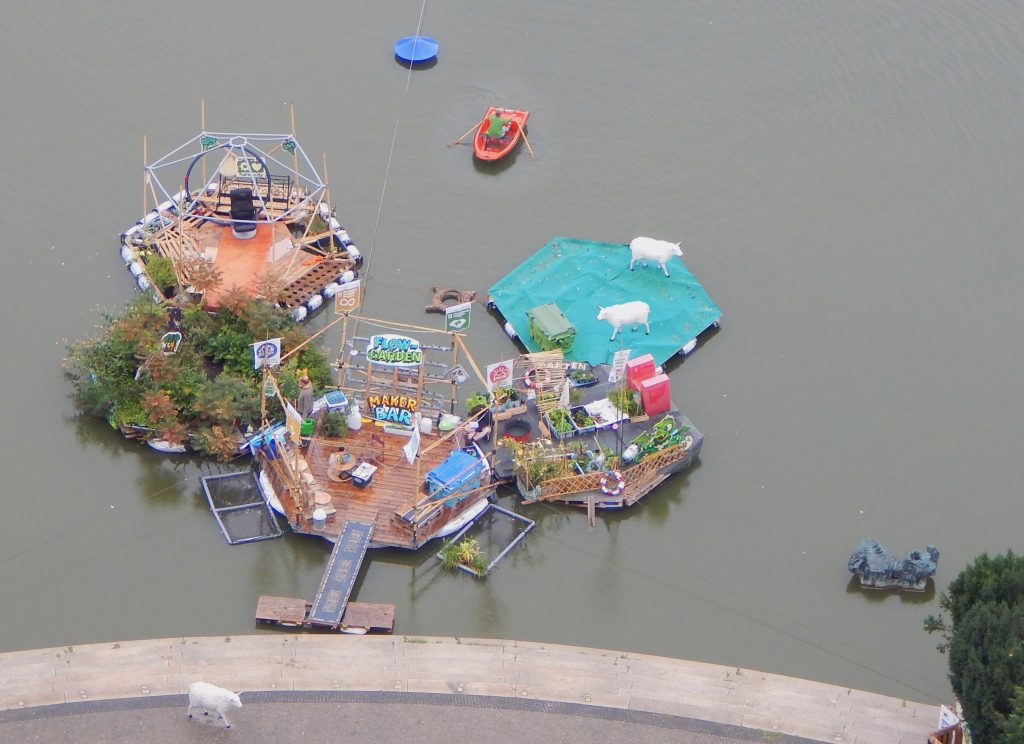Artist Interview with Joy Lohmann
The biennial Social Art Award highlights art projects that aim to create social impact. As ‘New Greening’ marked this year’s edition, we urged artists to explore new ways to re-generate greenery on our planet. With the Artist Interviews, we want to shed light on the winning artists. We gain more insight into how their projects relate to the concept of ‘New Greening’. Furthermore, the interviews generate discussion about how art can fuel social and environmental transformation.
With his project FlowGarden (2019), Joy Lohmann is the Social Art Award 2021 – Official Winner. After graduating in Art & Graphics (1992), Lohmann turned to street art, experimental photography and multimedia stage shows. His participatory events in public space range from experiential installations to real world multiplayer-games and interactive roadshows for sustainability. His art project entitled FlowGarden represents a floating unit in front of the town hall in Hanover. The modular island is created out of recycled material and brings people together by its “co-creative atmosphere”. In this interview, Joy Lohmann discusses the importance of social art and how it can impact our ways of living. We gain more insight into the difficulties that went along with his visionary ideas.
New Greening by floating islands
What does the New Greening Project mean to you and where does your artwork fit into the conversation?
“Initially, my floating art installations were meant to visualize the dangers of climate change and discuss societal transformation. However, the floating islands and gardens happened to become extremely flourishing biotopes with a huge humanitarian potential that reaches far beyond the art-scene. Therefore, we developed a DIY construction kit for floating islands that are adoptable on most inland waters as bird/fish sanctuaries, to grow food, to clean the water, to produce energy, or to be used as a rescue island in times of floods.
When it comes to climate change, we increasingly focus on upcoming catastrophes, their risks and dangers. With the Open-Island projects, we accept the scenario of vast flooded regions as a part of our future and look at options for mitigation and resilience in the most affected regions. The FlowGarden with its thriving biospheres and food production opened a new perspective: let’s utilize nutrient-rich flood waters for artificial gardens and artificial nature habitats, let’s rediscover the floating agriculture techniques of ancient civilizations like the Aztecs or the Egypt Empire, let’s join efforts with scientists to develop new organic materials from algae and other fast growing water plants, and let’s think about floating mangrove forests, organic sewage plants and other productive bio-innovations.
The FlowGarden was our proof-of-concept for easy-to-build modular floating platforms for many purposes. We hope to inspire other artists, scientists, engineers and entrepreneurs, or just the people in need to implement this system in their contexts and develop further innovations for New Greening on expanding water bodies.”

The transformative power of art
What do you think is the role of art in sustainable transformation?
“Social Art provides a free space for visionary concepts and societal experiments. You don´t have to prove the feasibility of a solution before developing it, like in other fields of our society.
Therefore, art enables us to keep thinking outside the box, which is helpful in many innovation processes. You don‘t even need to call it art and just use it as a method or mindset to solve problems or generate ideas. The concept of ‘Social Sculpture’ by Joseph Beuys (1921-1986) opens an artistic toolbox for everyone to become an artist her/himself in any deadlocked situation. Art inspires and provides the freedom for future shaping experiments and experiences.
The second role of Social Art is to find symbols, visualizations and narratives for our ongoing societal transformation. We need to visualize sustainable future scenarios with appealing pictures and desirable actions and strive for it by means of creativity and joy.”

Can you talk about the collaborative aspect of your art? What were your inspirations and how does community influence the perspective of your piece?
“Our floating islands always attract the most interesting people wherever we start a project, because of their archetypal symbol, the co-creative atmosphere and the practical benefit of our workcamps and installations. Within these interdisciplinary and co-creative design sprints, all people and organizations involved add skills, ideas, materials, and contacts to the common goal of the joint artwork. This collaborative process influences the floating islands and at the same time, the floating islands inspire the participants within their individual contexts.”
Visionary futures
Did/Do you face any limitations/shortcomings when turning the vision of your work into reality? If so, could you explain it?
“We came up with our slogan ‘The demand for floating islands rises with the sea-levels’ in 1998 when it wasn´t yet common to recognize climate change as a global danger. At that time, we often were disrespectfully called ‘do-gooders’ and naïve. If your artistic vision lies 10 years ahead of the general public understanding and the common zeitgeist, you will receive a lot of dumb reactions and little support. Sometimes, it is an exhausting job to explain the vision of your artwork to ignorant people or executives.
Sadly, the climate collapse became a tangible reality in the last decade and as a result, we don’t have acceptance problems for our low-tech, co-creative, floating island installations anymore. On the contrary, we nowadays experience an intuitive understanding for co-creative solutions by most people and many organizations within the ‘for-future’-movement and beyond. So, let’s be visionary again! Let´s think and act 10 years ahead, together!”

To what extent do you see your work bringing different meanings to the New Greening vision? What type of conversation does it introduce with respect to our future goals as a society and regarding sustainable transformation?
“Caused by our huge ecological footprints, we live in the geologic age of the Anthropocene. This new epoch is transforming the planet in a previously unthinkable speed with radical consequence. Beside reducing our negative impact, we must simultaneously increase our positive ecological handprints. This can, for example, be done by renaturation or reforestation projects but also through social art and innovation.
The FlowGarden shows and teaches practically how to build floating gardens and biotopes. The floating units can provide safe habitats for birds and maritime fauna, and even clean the water bodies they´re floating and growing on. We like to see many more floating gardens on rivers and lakes that promote ‘new greening’ and new practices of the Anthropocene-era.
In addition to our foot- and handprint, our ecological mind-prints might have the biggest impact for our everyday activities and decisions – and thus, for the entire planet. A big scale eco-cultural transformation of our societies is on its way. However, it needs more than knowledge to change old habits. Here, the floating islands provide great experiential spaces to holistically sense the interdependence of nature, humans and their impact.
On board of an Open-Island, you physically experience a fragile system with limited resources in midst nature. We are all sitting on the same boat to solve the challenges ahead. The floating islands symbolize and promote a cooperative way of feeling, thinking and acting together. We need more humanitarian maker spirits in all fields of society, to get things done purposefully for common welfare, not individual profit.”

FlowGarden and interspecies collaboration
As Joy Lohmann pointed out, scientists debate that we are currently living in a new era. The Anthropocene is a new epoch in which human impact on the climate and ecosystem is leaving indelible traces. Although it still is an unofficial epoch, it raises awareness about the route our planet is currently taking. By promoting new practices to tackle current environmental issues, social art offers revealing insights into different options for our future.
With his project FlowGarden, Lohmann encourages cooperation with local school classes and businesses (e.g. a local gin distillery). In doing so, they try to identify more sustainable ways of living together. However, his co-creative project goes beyond human-centered collaborations. FlowGarden has the remarkable ability to establish mutually beneficial relationships between humans and non-humans. Fish, for instance, use the floating island to enjoy its shade. Moreover, vegetables are cultivated in self-watering boxes on board. These are in turn used by the ducks and chicken to breed and live aboard the artificial islands. In other words, the floating islands can generate a thriving biosphere and develop new visions for multispecies futures.
Read more about Joy Lohmann’s open islands here: https://asapisland.wordpress.com
From 29 September you can view Joy Lohmann’s art interventions in the movie Träum weiter (Dream-on). The famous documentary filmmaker Valentin Thurn follows five visionary “dreamers” during their projects.
– Interview by Antje Jacobs
